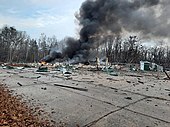State Border Guard Service of Ukraine
 From Wikipedia - Reading time: 19 min
From Wikipedia - Reading time: 19 min
| State Border Guard Service Державна прикордонна служба | |
|---|---|
 Service emblem | |
 Service flag | |
| Abbreviation | SBGS / ДПСУ |
| Agency overview | |
| Formed | July 31, 2003 |
| Preceding agency |
|
| Employees | ~ 60 000 (2022)[1] |
| Jurisdictional structure | |
| National agency | Ukraine |
| Operations jurisdiction | Ukraine |
| General nature | |
| Specialist jurisdiction |
|
| Operational structure | |
| Headquarters | 26, Volodymyrska st, Kyiv[2] |
| Agency executive |
|
| Parent agency | Ministry of Internal Affairs |
| Child agency | |
| Notables | |
| Significant operations | |
| Website | |
| dpsu.gov.ua | |
The State Border Guard Service of Ukraine (SBGS; Ukrainian: Державна Прикордонна Служба України, romanized: Derzhavna Prykordonna Sluzhba Ukrainy [derˈʒau̯nɐ prekɔrˈdɔnːɐ ˈsɫuʒbɐ ʊkrɐˈjine]; abbr. ДПСУ, DPSU) is the border guard of Ukraine. It is an independent law enforcement agency, organized by the Constitution of Ukraine as a military formation, the head of which is subordinated to the President of Ukraine.[4]
The Service was created on July 31, 2003, after the reorganization of the State Committee for Protection of the State Border. During wartime, units of the State Border Guard Service fall under the command of the Armed Forces of Ukraine. The State Border Guard Service includes the Ukrainian Sea Guard, which is the country's coast guard. It is also responsible for running Temporary Detention Centres, in which refugees are held.
History
[edit]Ukrainian border guards are the national successors of the Soviet Border Troops. They were formed from the approximately 17,000 Border Troops located in Ukraine in 1991. The organization was first titled the "Ukrainian Border Troops", which was later subordinated to the "Ukraine's State Committee for State Border Guarding".
From 1991 to at least 1993, the new borders with Russia and Belarus were not guarded; the Border Troops were only deployed along the western borders (minus Moldova) and on the Black Sea.[5] Another 9,000 personnel were added to the Border Troops at the expense of the Armed Forces of Ukraine, and, by the end of 1993, border posts were established in the north along the Russian and Belarusian borders. In 1999, the authorized strength of the force was again increased to 50,000.
In 2003, new legislation was adopted, and this somewhat changed the legal status of the institution. In March 2003, the Border Troops became the State Border Guard Service of Ukraine, and its status was legally changed from 'military formation' to 'special law-enforcement body.' The force was legally granted 50,000 personnel, including 8,000 civilian employees.
On 4 July 2012, a State Border Guard Service Diamond DA42 aircraft failed to make its scheduled radio contact with ground units. A Search and rescue mission revealed that the plane had crashed into a wooded mountainous area in Velykyi Bereznyi Raion, killing all 3 crew members on board. A further investigation was launched.[6]
During The War in Donbas on August 31, 2014, two Sea Guard Zhuk class patrol boats were struck by land-based artillery. In June 2, a border base in the outskirts of Luhansk was besieged by a troop of Luhansk People's Republic separatists. The Siege of the Luhansk Border Base resulted in 10 wounded Border Guards until they surrendered and withdrew.[7][8]
In 2022, during the Battle of Snake Island 13 border troops were attacked and captured by Russian warships. A unit of border guards was stationed in Mariupol and fought during the Siege of Mariupol. In 20 April, the border guards were stranded in an encircled pocket at the Mariupol sea port together with National Police of Ukraine, until they were rescued by the Azov Regiment and retreated into the Azovstal Iron and Steel Works.[9]
On 30 April 2024, Andriy Demchenko, spokesperson of the State Border Guard Service of Ukraine, said in an interview that 30 Ukrainians have died trying to leave since February 2024 when conscription was introduced. Since the implementation of martial law some 450 criminal gangs have been formed specialising in people smuggling.[10][11]
In April 2024, was announced the creation of the third combat brigade in the State Border Guard Service. The brigade was named Hart and Colonel Volodymyr Chervonenko became its commander.[12]
Structure
[edit]State Border Guard Service of Ukraine is a special enforcement branch tasked with the protection of Ukrainian state border on land, sea or any other inland water obstacle.[13] During wartime, the Border Guards units fall under the command of the Armed Forces of Ukraine.[14] They were the first Ukrainian units to counter Russian invasion on February 24, 2022.[15]
Mobile response units
[edit]- Dozor Detachment
- Pomsta Brigade (former Luhansk Detachment)
- Stalevy Kordon Infantry Brigade
- Hart Brigade (former Donetsk Detachment)
- Forpost Brigade (former Kramatorsk Detachment)
Border detachments
[edit]- Berdyansk Detachment
- Bilhorod-Dnistrovskyi Detachment
- Chernihiv Detachment
- Chernivtsi Detachment
- Chop Detachment
- Izmail Detachment
- Kharkiv Detachment
- Kherson Detachment
- Lutsk Detachment
- Lviv Detachment
- Mohyliv-Podilskyi Detachment
- Mukachevo Detachment
- Odesa Detachment
- Podilsk Detachment
- Shostka Detachment
- Sumy Detachment
- Zhytomyr Detachment
Maritime Security
[edit]Aviation
[edit]- Lviv Aviation Squadron
- Kharkiv Aviation Squadron
- Odesa Aviation Squadron
Volunteer Units
[edit]- Cossack Regiment Shevchenko
- Special Purpose Battalion Sever
Commanders
[edit]Directors (commanders) of the Border Guard Service (border troops):
- 1991–1994: Valeriy Hubenko
- 1994–1999: Viktor Bannykh
- 1999–2001: Borys Oleksiyenko
- 2001–2014: Mykola Lytvyn[16]
- 2014–2017: Viktor Nazarenko[16][17]
- 2017–2019: Petro Tsyhykal
- 2019–present: Serhii Deineko[18]
Military ranks
[edit]Uniform
[edit]-
Patch
-
Cockade
-
Officers cocarde
-
Privates cocarde
Long service medal
[edit]-
25 years in service
-
20 years in service
-
15 years in service
-
10 years in service
Equipment
[edit]| Model | Image | Origin | Variant | Number | Details |
|---|---|---|---|---|---|
| Anti-tank | |||||
| Stugna-P | 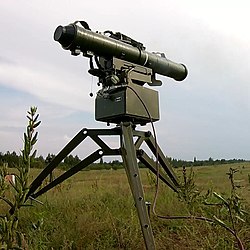
|
[19] | |||
| NLAW | 
|
Several hundred | Used by the Luhansk border guards.[20] | ||
| SPG-9 | 
|
SPG-9M ATGL-H |
Bulgarian made rifles are also used.[21] | ||
| Artillery | |||||
| DITA | 
|
First shown by the SBGS in January 2025[22][23] | |||
| BS-3 | 
|
Reactivated after the 2022 Russian invasion.[24] | |||
| RAK-12 | 
|
RAK-SA-12 | [25] | ||
| ZU-23-2 | 
|
ZU-23-2CP | Used on static positions or mounted on trucks.[26] | ||
| Armoured personnel carrier | |||||
| BM Triton | 
|
63 | [27] | ||
| Roshel Senator | 
|
Used by the Chernihiv border guards.[28] | |||
| M113 | 
|
50 | Purchased by the Ukrainian Ministry of Energy and energy sector companies.[29] | ||
| MRAP | |||||
| Kozak |  |
Kozak-2 | 17 | [30] | |
| KRAZ Cougar |  |
3+ | [31] | ||
| Alvis 4[32] | 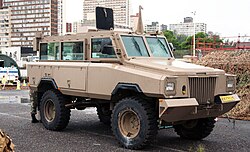
|
7 | Donated by Estonia.[33] | ||
| Logistics and utility vehicles | |||||
| Ural-4320 | 
|
Medium truck | [34] | ||
| ZiL-131 | 
|
Medium truck | [34] | ||
| GAZ-66 | 
|
Medium truck (2 tonnes) | [34] | ||
| KamAZ-5320 | 
|
Heavy truck (8 tonnes) | [34] | ||
| KamAZ-4310 | 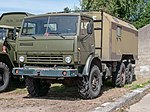
|
Heavy truck (6 tonnes) | [34] | ||
| KAMAZ-43114 | 
|
Heavy truck (6 tonnes) | Purchased prior to the Russo-Ukrainian war.[34] | ||
| KrAZ-257 | 
|
Heavy truck (12 tonnes) | [34] | ||
| KrAZ-255B | 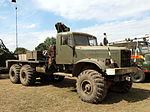
|
Heavy truck (12 tonnes) | [34] | ||
| KrAZ-260 | 
|
Heavy truck | [34] | ||
| KrAZ-6322 | 
|
Heavy truck | [34] | ||
| KrAZ-6510 | 
|
Dump truck | [34] | ||
| KrAZ-5233 | 
|
Heavy truck (6 tonnes) | [34] | ||
| IVECO Trakker | 
|
Dump truck | Donated by Germany.[35] | ||
| Mercedes Benz Unimog | 
|
Truck | Donated by Germany.[35] | ||
| UAZ-3163 | 
|
Off-road vehicle | [36] | ||
| Land Rover Defender | 
|
Off-road vehicle | 55[37][38] | ||
| Volkswagen Amarok | 
|
Off-road vehicle | 20[39] | ||
| Toyota Land Cruiser 200[broken anchor] | 
|
Off-road vehicle | 20[40] | ||
| Dacia Duster | 
|
Off-road vehicle | 10[41] | ||
| UAZ-3303 | 
|
Off-road vehicle | [42] | ||
| Mitsubishi L200 | 
|
Off-road vehicle | 40 | Donated by the US in 2021.[43] | |
| UAZ-3962 | 
|
[44] | |||
| Volkswagen Transporter | 
|
Bus | 10[41][45] | ||
| Ford Transit | 
|
Bus | 10[46] | ||
| Bogdan A092 | 
|
Bus | [47] | ||
| ЛАЗ-695 | 
|
Bus | [48][49] | ||
| Rosenbauer Panther | 
|
Airport crash tender | 2 | Donated by Germany.[50] | |
| Other vehicles | |||||
| Bombardier Outlander 400 MAX | 
|
100[51] | |||
| Polaris 600 IQ Touring | 
|
50[52] | |||
| Caterpillar 336-08 | 
|
1 | Donated by Germany.[35] | ||
| Aircraft | |||||
| Antonov An-8 | 
|
Used by the Sea Guard.[32] | |||
| Antonov An-24 | 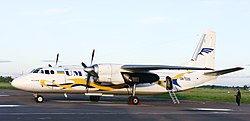
|
Used by the Sea Guard.[32] | |||
| Antonov An-26 | 
|
Used by the Sea Guard.[32] | |||
| Antonov An-72 | 
|
Used by the Sea Guard.[32] | |||
Gallery
[edit]See also
[edit]- Border control
- State Border of Ukraine
- Security Service of Ukraine
- List of national border guard agencies
References
[edit]- ^ "Мільйон українців у формі захищає Україну від росіян". July 9, 2022.
- ^ "Official website of the authority.Contact Us". 2017.
- ^ "УКАЗ ПРЕЗИДЕНТА УКРАЇНИ №403/2019". Official website of the President of Ukraine (in Ukrainian). Retrieved 2019-06-14.
- ^ "Main tasks of the State Border Guard Service of Ukraine". dpsu.gov.ua. Retrieved 2022-08-05.
- ^ Leonid Polyakov, 'Paramilitary Structures in Ukraine,' Almanac on Security Sector Governance in Ukraine 2010, 143-144, Geneva Centre for the Democratic Control of Armed Forces.
- ^ "Фотографии с места катастрофы самолета Diamond DA-42 в Закарпатье". Reporter UA. July 5, 2012.
- ^ Qena, Nebi (2014-06-04). "6 militants killed, 3 Ukrainian troops injured in Luhansk fighting". CTVNews. Retrieved 2022-05-01.
- ^ "500 separatists storm border control building in Luhansk, Ukraine". UPI. Retrieved 2022-05-01.
- ^ "Marines and "Azov" rescue 500 fighters from the port of Mariupol - media". Ukrayinska Pravda. Retrieved 2022-05-01.
- ^ "Ukrainian border chief says 30 people have died trying to flee the country". Euronews. 2024-04-30. Retrieved 2024-04-30.
- ^ "Андрій Демченко, речник Державної прикордонної служби". www.ukrinform.ua (in Ukrainian). Retrieved 2024-11-01.
- ^ "Ukraine's Interior Minister announces creation of another brigade, formed of border guards". Ukrainska Pravda. Retrieved 2024-11-02.
- ^ "With Invasion of Ukraine, Security Council's 2022 Efforts to Maintain International Peace, Stability Mired by Widening Rifts between Veto-Wielding Members - World | ReliefWeb". reliefweb.int. 12 January 2023. Retrieved 2023-02-20.
- ^ Chao-Fong, Léonie; Thomas, Tobi; Beazley, Jordyn (2023-02-07). "Kyiv claims last 24 hours was deadliest day of conflict for Russian troops – as it happened". the Guardian. ISSN 0261-3077. Retrieved 2023-02-20.
- ^ Lister, Tim (2023-02-20). "After nearly one year of war, how Ukraine defied the odds — and may still defeat Russia". CNN. Retrieved 2023-02-20.
- ^ a b President appoints Nazarenko as new border chief, Interfax-Ukraine (23 October 2014)
- ^ Poroshenko appoints Head of Operations Department Tsyhykal as State Border Service chief, Interfax-Ukraine (25 July 2017)
- ^ Zelensky appoints new chief border guard, UNIAN (14 June 2019)
- ^ "HE missiles for Stugna ATGM were spotted on the frontline". Militarnyi. Retrieved 11 November 2023.
- ^ "Border guards in Luhansk region were armed with NLAW ATGMs". Militarnyi. Retrieved 11 November 2023.
- ^ "Ukrainian paratroopers equipped with SPG-9 are destroying the equipment and trenches of Russian infantry". Militarnyi. Retrieved 11 November 2023.
- ^ "(VIDEO) Aid from the Czech Republic – Border Guards Master New Modern Weapons and Military Equipment". dpsu.gov.ua. Retrieved 2025-02-10.
- ^ "Czechia delivers DITA self-propelled artillery system to Ukrainian border guards – video". Ukrainska Pravda. Retrieved 2025-02-10.
- ^ "Ukrainian Armed Forces have been armed with BS-3 field guns". Militarnyi. Retrieved 11 November 2023.
- ^ "Ukrainian Border Guards received Croatian RAK-SA-12 MRL". Militarnyi. Retrieved 11 November 2023.
- ^ "Ukrainian border guards received new ZU-23-2 anti-aircraft guns". Militarnyi. Retrieved 2 January 2024.
- ^ Malyasov, Dylan. "State Border Guard Service Of Ukraine Will Receive 62 New "Triton" Reconnaissance Vehicle". Defence Blog. Retrieved 11 November 2023.
- ^ "Chernihiv border guards receive Senator APC armored vehicles". Militarnyi. Retrieved 11 November 2023.
- ^ "Ukrainian power companies buy 50 M113 APCs for border guards". Militarnyi. Retrieved 11 November 2023.
- ^ International Institute for Strategic Studies (2022). The Military Balance 2022 (Report). Abingdon, Oxon. p. 214. ISBN 978-1032279008.
- ^ "Ukrainian Border Guard has received the new batch of KrAZ "Kuguar" light armored personnel carriers". State Border Guard Service of Ukraine Official Website. Retrieved 11 November 2023.
- ^ a b c d e International Institute for Strategic Studies (13 February 2024). "Russia and Eurasia". The Military Balance 2024. 124. Taylor & Francis: 210−215.
- ^ Janovsky, Jakub; naalsio26; Aloha; Dan; Kemal (8 June 2023). "Tallinn's Tally: Estonia's Weapons Supplies To Ukraine". Oryx. Retrieved 17 March 2024.
{{cite web}}: CS1 maint: numeric names: authors list (link) - ^ a b c d e f g h i j k l B., Volodymyr. "Unified truck platform for the Ukrainian Defense Forces: KrAZ, MAZ, or Tatra?". Militarnyi. Retrieved 28 October 2023.
- ^ a b c "Ukrainian border guards receive aircraft refuelers and trucks from Germany". Militarnyi. Retrieved 11 November 2023.
- ^ "Cпеціальні навчання мобільних підрозділів". Archived from the original on February 15, 2015.
- ^ "Державна прикордонна служба України отримала сучасну автомобільну техніку та обладнання майже на 135 мільйонів гривень". Archived from the original on February 13, 2015.
- ^ "МИНОБОРОНЫ, СБУ, МВД И ГОСПОГРАНСЛУЖБА УКРАИНЫ ПОЛУЧИЛИ ОТ ГОСУДАРСТВА НОВЫЕ АВТОМОБИЛИ СКОРОЙ МЕДИЦИНСКОЙ ПОМОЩИ". Archived from the original on February 24, 2015.
- ^ «ЗакарпатевроТранс II» переоборудовал авто на спецзаказ от Госпогранслужбы Archived 2016-01-16 at the Wayback Machine
- ^ "Пограничникам подарили бронированные Volkswagen и Toyota". Archived from the original on February 15, 2015.
- ^ a b "Львівські прикордонники отримали сучасну техніку від ЄС (фоторепортаж)". Archived from the original on March 27, 2015.
- ^ "Прикордонники їдуть на східний кордон. Хмельницький" – via www.youtube.com.
- ^ Pryma, Andrew (9 February 2022). "Ukrainian State border guards received the first batch of SUVs from the USA". UBN. Retrieved 12 November 2023.
- ^ "Bogdan Corporation hands over some 50 upgraded Bogdan 2251 ambulance vehicles to Armed Forces in Aug". Interfax-Ukraine. 10 September 2018. Retrieved 3 January 2024.
- ^ "Украинские пограничники пересядут на новые микроавтобусы Volkswagen | авто портал приазовья". avtoazov.com.ua.
- ^ "Автомобили Ford Transit - на защите границ Украины – Автоцентр.ua". Автоцентр. May 21, 2012.
- ^ "MORE THAN 500 BUS RIDES HAVE BEEN ORGANISED TO TRANSPORT 22,000 CITIZENS WHO CAME TO THE BORDER ON FOOT". dpsu.gov.ua. 3 April 2020. Retrieved 5 January 2024.
- ^ "Просмотр фотографии". transit.parovoz.com.
- ^ "Закарпатці повернулися із пекла війни (ФОТО)".
- ^ "Ukrainian border guards received airfield fire trucks from Germany". Militarnyi. Retrieved 11 November 2023.
- ^ В Государственной пограничной службе Украины подвели годовые итоги и определили основные направления деятельности в 2013 году Archived 2014-03-22 at the Wayback Machine
- ^ "Харьковские пограничники отметили 20-летие Восточного управления погранслужбы - Новости Харькова и Харьковской области. МГ «Объектив»". archive.objectiv.tv.
 KSF
KSF







